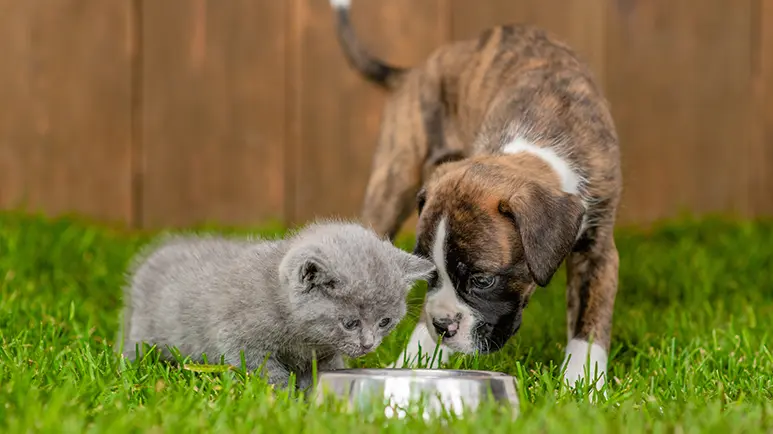Quickly Leads to Death If You Ignore This Threat
It's very easy for humans to equate this to a known human symptom. But where cats and dogs are concerned, you'd be mistaken on this. Instead, check out this telltale sign your pet is quickly headed down the wrong road, and needs fast help to save his life. So please don't ignore.

STORY AT-A-GLANCE
- Dehydration is different from thirst because it is potentially life-threatening, plus not all dehydrated pets have thirst as a symptom
- There are many causes of dehydration in dogs and cats, the most common of which is fluid loss from the urinary or GI tract
- One way to check your pet’s hydration level is to gently lift a bit of skin at the back of the neck; if it stays up like a tent, your dog or cat could be dehydrated
- The most important step in diagnosing dehydration is finding the underlying cause and resolving it
- One of the best things you can do to keep your dog or cat well-hydrated is to feed a moisture-rich, species-appropriate diet
Editor's Note: This article is a reprint. It was originally published August 06, 2017.
Many people mistakenly think that dehydration and thirst are more or less the same. While it's true that feeling thirsty is one of the ways our bodies remind us to hydrate, dehydration is actually a potentially life-threatening medical condition that doesn't always have thirst as a symptom.
The medical term for dehydration, "low circulating blood volume," provides a better clue as to just how serious the condition can be. Dehydration reduces the volume of both blood and intracellular fluids flowing through the body, which in turn reduces oxygen delivery to tissues and organs, as well as the removal of waste products.
Dehydration also throws off the balance of electrolytes, such as calcium, magnesium, sodium and potassium, which can interfere with the normal function of the body's organs and systems. If a dehydrated pet isn't quickly rehydrated, death can occur very quickly. Dehydration occurs when the body loses more fluid than it takes in. This can happen from lack of food and liquids. It can also happen as a result of increased fluid loss through urination, diarrhea or blood loss. For a pet who is ill, both circumstances usually apply.
An animal who is vomiting, has diarrhea or is dealing with, for example, pneumonia or who has experienced blood loss will either refuse to eat or drink, or be unable to eat or drink enough to keep up with the fluid loss occurring in his body. The inability to replace fluids that have been lost can get a pet into trouble very quickly.
Causes of Dehydration
Dehydration can be caused by a number of disorders and diseases. Any condition that inflames or irritates any region of the gastrointestinal (GI) tract, from the mouth to the rectum, can cause fluid loss and dehydration.
Examples include excessive drooling, panting, ulcers, a bacterial, viral or fungal infection, GI parasites or an obstruction in the digestive tract. Vomiting and diarrhea, which can be caused by any number of problems, are primary causes of dehydration in dogs and cats. Other causes of fluid loss include:
- Kidney disease
- Burns or a large injury to the skin
- Ingestion of a toxin such as ethylene glycol, which is found in antifreeze
- Endocrine system diseases such as diabetes mellitus, diabetes insipidus and Addison's disease
- Heat stroke
By far, the most common trigger for dehydration in domestic dogs and cats is fluid loss from the urinary and/or GI tract. Sadly, two other very common and entirely preventable causes of dehydration in dogs are being left outside in hot weather, and an outdoor water dish that freezes over.
Symptoms of Dehydration
The symptoms of dehydration are the result of an imbalance of the body's electrolytes and can impact virtually every organ system in your dog's or cat's body, including the GI tract, the central nervous system, muscles, kidneys, the respiratory tract, blood pressure and heart function.
Signs to watch for include skin "tenting," meaning that when you gently lift a bit of skin at the back of your pet's neck, it stays up like a tent and sort of stuck together. In a hydrated pet, the skin snaps right back. Other symptoms of dehydration include:
- Loose or wrinkled skin
- Rapid weight loss
- Depression
- Elevated heart rate
- Vomiting
- Excessive urination
- Panting
- Weak pulse quality/strength
- Diarrhea
- Lethargy
- Excessive drooling
- Sunken eyes
- Lack of appetite
- Weakness
- Sticky, dry gums
- Collapse
Diagnosing Dehydration
Significant dehydration in and of itself can be pretty easy for a veterinarian to spot. Even if it isn't immediately obvious when the vet examines the animal, since the condition goes hand-in-hand with many common dog and cat ailments, we can reasonably assume that if a pet has been vomiting, has had diarrhea or isn't eating or drinking, he or she is most likely dehydrated.
The bigger challenge is to identify the underlying cause of the dehydration, because it's almost always a symptom of some other issue. Diagnostic tests will include a complete blood count and serum biochemistry profile, packed cell volume (PCV), total plasma protein (TPP) tests, a urinalysis and a fecal test to check for GI parasites.
The results of these tests will tell your veterinarian a great deal about your pet's overall health and organ function, and can point to the existence of dehydration. Increased packed cell volume and total plasma protein levels plus an abnormal result for urine specific gravity definitively point to moderate to severe dehydration.
Depending on the results of these initial diagnostic tests, additional tests may be required to identify the root cause your pet's dehydration. These can include x-rays, ultrasound imaging, urine or fecal cultures, tests for toxin ingestion, tests to assess the function of the adrenal glands and/or a barium study to evaluate the structures of the GI tract.
Very young and geriatric pets who lose their appetites or have even just a couple of episodes of vomiting or diarrhea can dehydrate very quickly and should be seen by a veterinarian right away. A sudden decrease in body weight is an important clue that your pet has also suffered an acute loss of body water.
Treatment for Dehydration
The goals for treating dehydration in a pet are to replace the fluids that have been lost, correct any electrolyte abnormalities and identify and resolve the underlying cause. A moderately to severely dehydrated pet will need to be hospitalized and given intravenous (IV) fluids and an electrolyte solution slowly over 24 to 48 hours, depending on the level of dehydration. The fluid replacement rate is calculated based on the severity of the dehydration and the animal's size, weight, overall health and other factors.
Typically these patients will also receive heart rate and blood pressure monitoring and other types of monitoring, including urine output and body weight. Correcting dehydration is really as simple as administering fluids back into the body to replace what has been lost. However, the challenge is to learn why your pet became dehydrated in the first place.
Preventing Dehydration in Your Pet
Dogs and especially cats are designed to get much of the water their bodies need from the food they eat, so make sure you're feeding a species-appropriate balanced diet that is naturally moisture-dense. This does not include kibble, which has very low moisture content.
The average kibble has about 11 percent moisture. A dog's and cat's evolutionary diet contains about 70 percent. If a kibble-consuming pet isn't drinking the extra water needed for hydration, he can live in a constant state of low-grade dehydration. Dry food is especially problematic for cats, because they don't tend to drink as much as dogs drink. They end up being mildly dehydrated much of the time.
Leave multiple bowls of clean filtered water in glass or stainless steel bowls around the house to encourage your pet to drink. Replace the water several times a day. You can also use a pet water fountain. I have kitty patients who will only drink from a fountain or from a dripping sink faucet.
If your pet doesn't seem to be drinking enough from his bowl, try adding some bone broth to the water, or the juice from a can of sardines. I've also had good success adding an all-natural electrolyte tablet called Bioplasma to drinking water. If your pet is throwing up or has diarrhea that doesn't resolve in a day or so, it's a good idea to call your vet. This is absolutely crucial in the case of very young pets, senior and geriatric animals and pets who are chronically ill.










